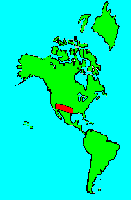SPECIES INFO
Viola charlestonensis is a local species found in Zion National Park in Utah and the Charleston Mountains in southern Nevada. This probably also occurs above 8,000 feet in Arizona. The leaves are entire.Viola genus ( violet) is found worldwide in the north temperate zones and also south from North America to the Andes Mountains. There are about 500 to 600 species of herbs and shrublets in this genus, with 84 species, 33 hybrids, and an additional 64 subspecies living in greater North America.
The herbs may or may not have stems. Many species have flowers on separate stalks from the leaves. The flowers are 5-petaled. The lowest petal is usually the largest and is frequently spurred. Most species bloom early in the spring. The lack or presence of hairs on the inside of the various petals near the base help identify the different members of this genus. Many of these plants are favorites with gardeners.
With the large number of species in the genus, we have arbitrarily divided the genus into several groups:
Viola-G is used for violets that are of garden origin (our sort code 80)
Viola-E is used for Violets of Eurasia including introductions to N. America.(84)
Viola is used for unsorted North American violets. (our sort code 89)
Viola-B is used for blue, violet, or purple of North America (90)
Viola-W is used for white violets of North America (our internal sort code 95)
Viola-Y Is used for Violets that are yellow of North America.( our sort code 96)
Viola-H is used for Violets that are native to Hawaii. (our sort code 98)
(Please remember the distinction between white and blue is not always obvious. )
North American violets (Genus Viola) that have not been coded to flower color.
Violet (Violacea) family contains not only the familiar violets (Genus Viola) but also about twenty different additional genera. The family is very widespread in the world including the tropics and the colder southern and northern extremes. There are about 800-900 species in this worldwide family arranged in 22-23 different genera. There are 92 species in greater North America arranged in three different genera.
The flowers in the violet genus can be blue to purple, white, yellow, or variable. The leaves can be of many different shapes. We have divided the violet family at the genus level into different groups based on color.
The term "Dog Violet" appears to be used primarily for members of the Viola genus that have flower stems and leaves on a larger stem. (Most violets (genus Viola) have basal leaves and a basal flower stalk.)
Parietales Order is a large assemblage containing over thirty different families. The violets are a well-known group in this order. The St. Johnswort family is another well known family in this order. Passion flowers also belong here.
Some authors argue this order should be divided, and others have divided it into several orders.
Dicots (Dicotyledoneae Class) are the predominant group of vascular plants on earth. With the exception of the grasses (Monocots) and the Conifers (Gymnosperms), most of the larger plants that one encounters are Dicots. Dicots are characterized by having a seed with two outer shell coverings.
Some of the more primitive Dicots are the typical hardwood trees (oaks, birches, hickories, etc). The more advanced Dicots include many of the Composite (Aster) Family flowers like the Dandelion, Aster, Thistles, and Sunflowers. Although many Monocots reach a very high degree of specialization, most botanists feel that the Dicots represent the most advanced group of plants.
Seed plants (Phylum Embryophyta) are generally grouped into one large phylum containing three major classes: the Gymnosperms, the Monocots, and the Dicots. (Some scientists separate the Gymnosperms into a separate phylum and refer to the remaining plants as flowering plants or Angiospermae.)
For North American counts of the number of species in each genus and family, the primary reference has been John T. Kartesz, author of A Synonymized Checklist of the Vascular Flora of the United States, Canada, and Greenland (1994). The geographical scope of his lists include, as part of greater North America, Hawaii, Alaska, Greenland, Puerto Rico, and the Virgin Islands.
Kartesz lists 21,757 species of vascular plants comprising the ferns, gymnosperms and flowering plants as being found in greater North America (including Alaska, Hawaii, Greenland, Puerto Rico and the Virgin Islands.
There are estimates within the scientific world that about half of the listed North American seed plants were originally native with the balance being comprised of Eurasian and tropical plants that have become established.
Plant kingdom contains a large variety of different organisms including mosses, ferns, and seed plants. Most plants manufacture their energy from sunlight and water. Identification of many species is difficult in that most individual plants have characteristics that have variables based on soil moisture, soil chemistry, and sunlight.
Because of the difficulty in learning and identifying different plant groups, specialists have emerged that study only a limited group of plants. These specialists revise the taxonomy and give us detailed descriptions and ranges of the various species. Their results are published in technical journals and written with highly specialized words that apply to a specific group.
On the other hand, there are the nature publishers. These people and companies undertake the challenging task of trying to provide easy to use pictures and descriptions to identify those species.

